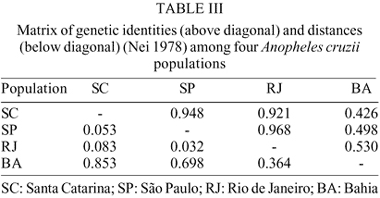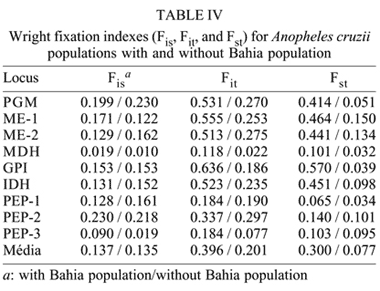Anopheles cruzii is a small sylvatic mosquito and primary human Plasmodium vector in Southern Brazil. The distribution of this bromeliad-breeding mosquito follows the Atlantic forest coastal distribution, where bromeliads are abundant. Morphological, genetic, and molecular polymorphisms among different populations have been reported and it has recently been suggested that An. cruzii is a complex of cryptic species. The aim of this work is to analyze the gene flow between different populations of An. cruzii collected in four localities within the geographic distribution range of the species, and to examine if An. cruzii is a complex of cryptic species. The genetic distances show that populations of the states of Santa Catarina, São Paulo, and Rio de Janeiro are genetically closer (0.032 to 0.083) than populations of Bahia (0.364 to 0.853) based on profiles from 10 distinct isoenzyme loci. The Fst was lower (0.077) when the Bahia population was excluded than when it was included (0.300) in the analyses. The inferred number of migrants per generation was 2.99 individuals among populations from the states of Santa Catarina, São Paulo, and Rio de Janeiro and 0.58 migrants per generation among all populations. Results suggest that An. cruzii is a complex of species and that the specimes of state of Bahia can be considered as belonging to a species that is distinct from other three closely-related populations studied.
isoenzyme; Anopheles cruzi; Kerteszia; cryptic species






